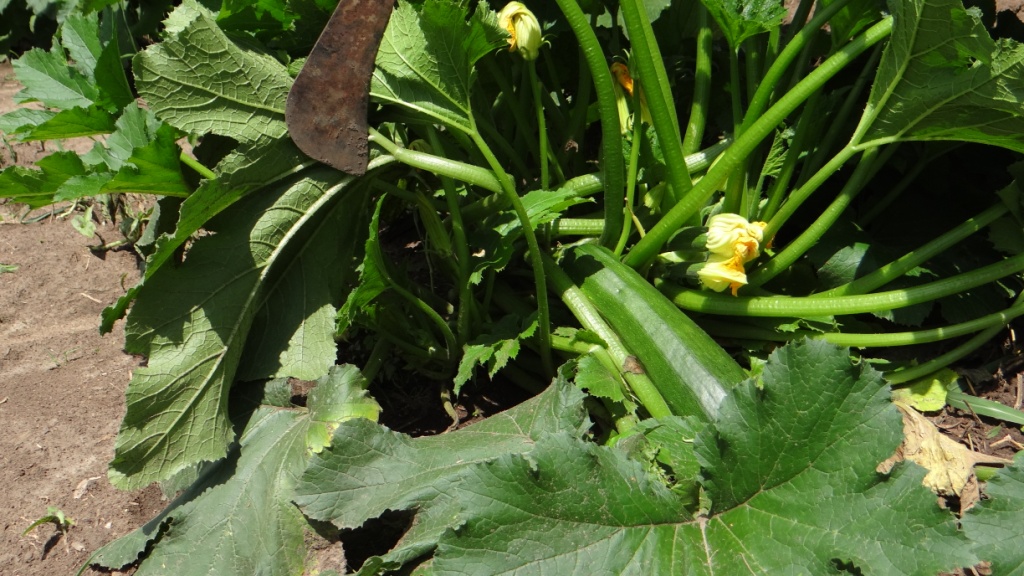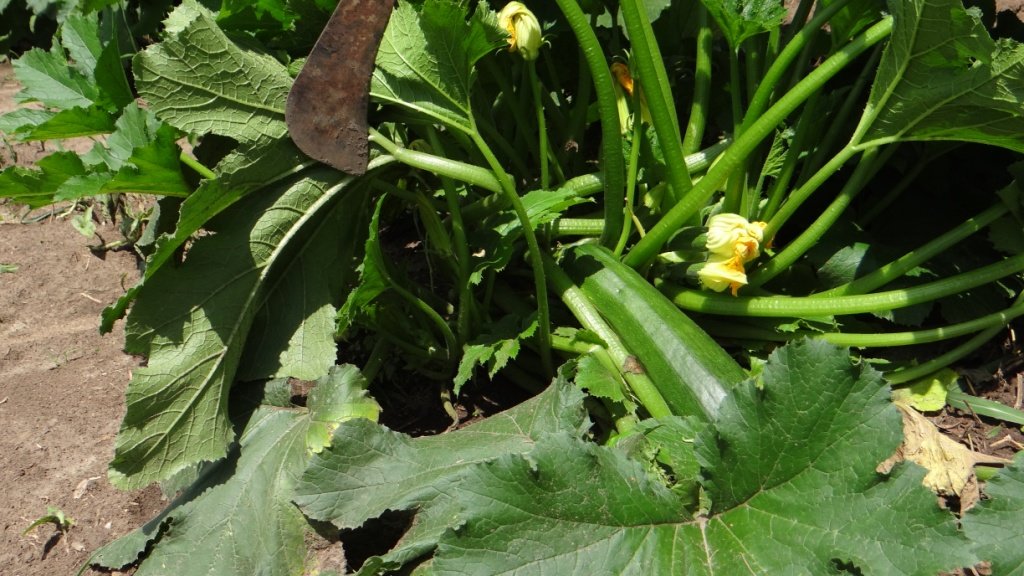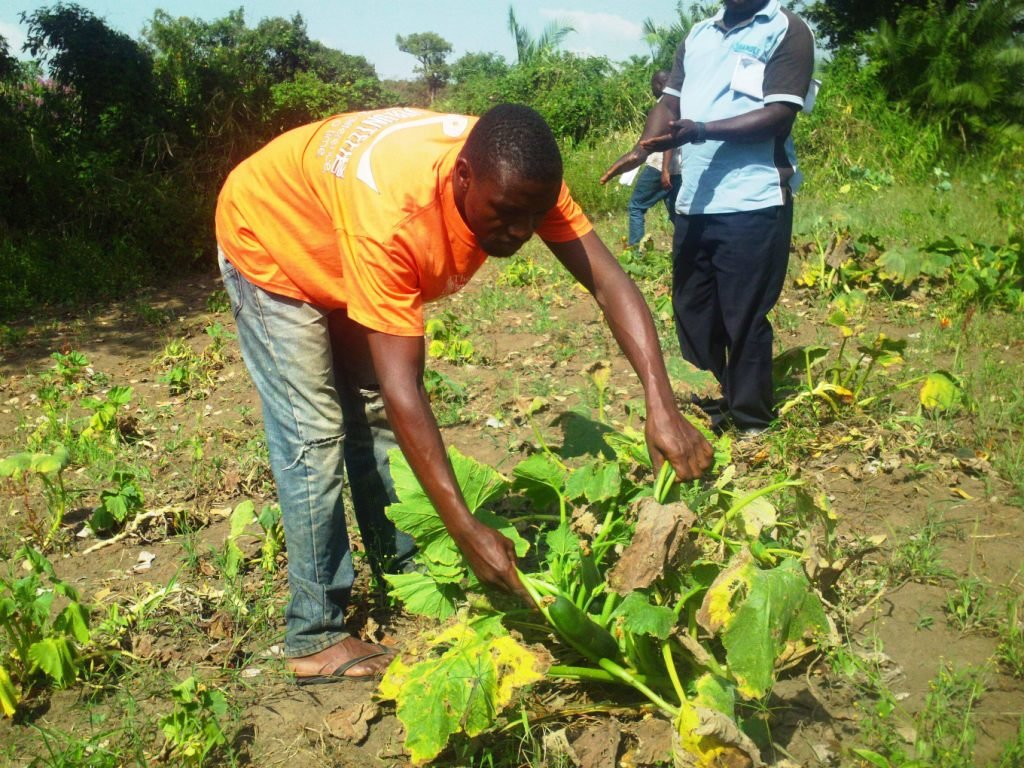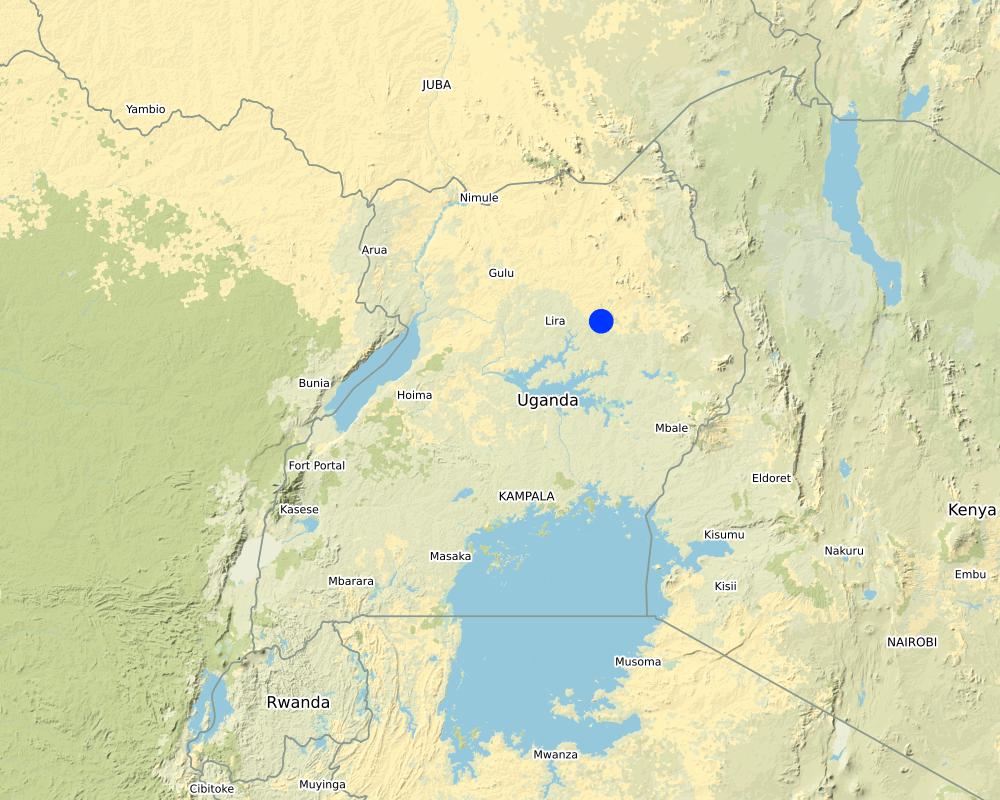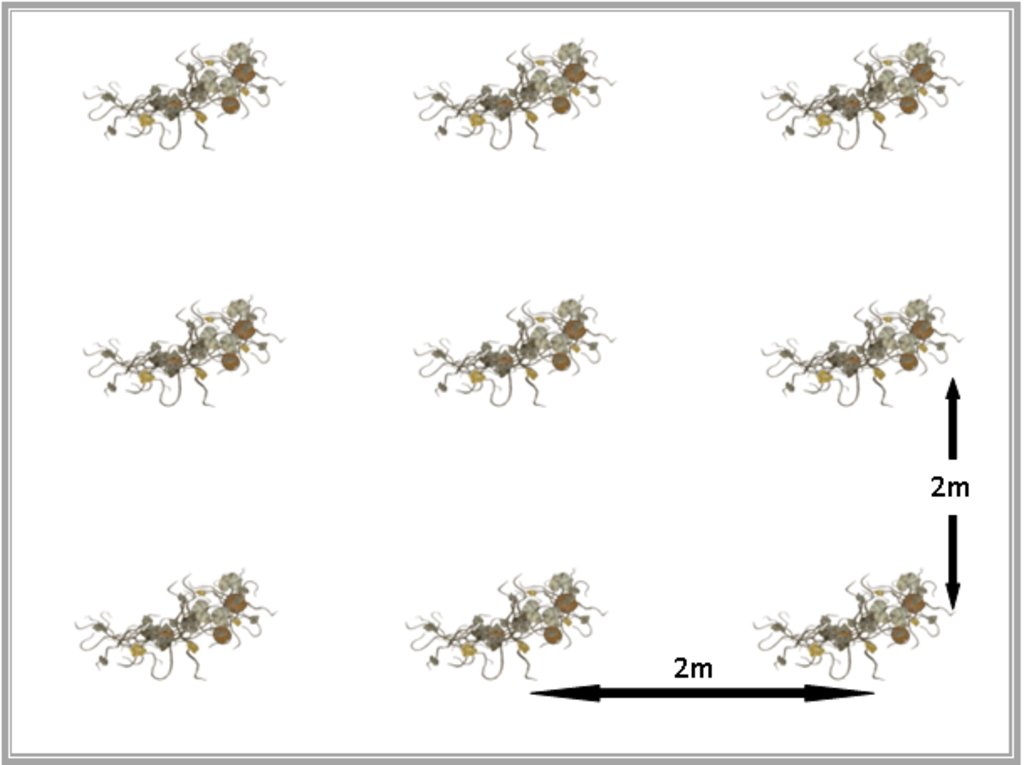Baby Melon as a Cover-Crop in Lowlands [乌干达]
- 创建:
- 更新:
- 编制者: Bernard Fungo
- 编辑者: JOY TUKAHIRWA, Kamugisha Rick Nelson, Sunday Balla Amale, betty adoch
- 审查者: Drake Mubiru, Udo Höggel
Pito kodi pi gengo wi ngom
technologies_2822 - 乌干达
查看章节
全部展开 全部收起1. 一般信息
1.2 参与该技术评估和文件编制的资源人员和机构的联系方式
关键资源人
Manager:
Mwebesa Nelson
+256777945474
Koro sub county, Omoro district
乌干达
有助于对技术进行记录/评估的项目名称(如相关)
Scaling-up SLM practices by smallholder farmers (IFAD)有助于对技术进行记录/评估的机构名称(如相关)
Uganda Landcare Network (ULN) - 乌干达1.3 关于使用通过WOCAT记录的数据的条件
(现场)数据是什么时候汇编的?:
11/05/2017
编制者和关键资源人员接受有关使用通过WOCAT记录数据的条件。:
是
1.4 所述技术的可持续性声明
这里所描述的技术在土地退化方面是否存在问题,导致无法被认为是一种可持续的土地管理技术?:
否
2. SLM技术的说明
2.1 技术简介
技术定义:
Baby melon (cucumis melo) is used as a cover-crop to prevent soil degradation
2.2 技术的详细说明
说明:
Baby melon, as a cover crop, protects soil from erosion and compaction due to rain drops. The cover crop also conserves soil moisture during drought periods. Besides soil conservation, baby melon is used as source of food and income to the land user. It is a vegetable crop which looks like pumpkin with wide leave and scroll on the surface of the land and has the ability to prevent soil erosion from run-off. The crop is also commonly grown along streams where it protects the banks from erosion, provides manure through leaf-fall, and reduces the risk of flooding by increasing the evopo-transpiration from its wide leaves.
To establish this cover crop, farmers use seeds, which is locally conserved from previous fruiting or bought from agro-input shop. Seeds are sown directly into a pre-cultivated garden. Usually planting is at a spacing of two meters. Planting is usually done at the start of the rainy season. Weeding, as well as pest and disease management is done the way pumpkins are usually managed. Fruits are harvested at a relatively early stage (~2 months after planting). A more juvenile fruit is preferred to the more grown one for its nutritional value.
The benefit of the technology is first for food, income and also for protection of the soil from the effect of running water and rain drops. The farmer obtains nutritious food from the fruits of this plant. The plants also prevent soil erosion and take a very short time to mature. When the plant covers an area, it reduces weed growth, thus reducing the cost of weeding. One disadvantage of this technology is that the pumpkins do not have a popular market and have a very short shelf life. Fruits therefore, have to be sold immediately after harvesting. The market value of the crop is generally low.
2.3 技术照片
2.4 技术视频
日期:
11/05/2016
位置:
Omoro District
摄影师的名字:
Isa Aiga and Sunday Balla Amale
2.5 已应用该技术的、本评估所涵盖的国家/地区/地点
国家:
乌干达
区域/州/省:
Northern Region,Uganda
有关地点的进一步说明:
Koro Subcounty, Omoro District
Map
×2.6 实施日期
如果不知道确切的年份,请说明大概的日期:
- 不到10年前(最近)
2.7 技术介绍
详细说明该技术是如何引入的:
- 通过项目/外部干预
注释(项目类型等):
The annual crop used as a vegetable
3. SLM技术的分类
3.1 该技术的主要目的
- 减少、预防、恢复土地退化
- 保护生态系统
3.2 应用该技术的当前土地利用类型

农田
- 一年一作
主要农作物(经济作物及粮食作物):
Maize, Sorghum
3.3 有关土地利用的更多信息
该技术所应用土地的供水:
- 雨养
每年的生长季节数:
- 2
具体说明:
March to May and September to November
3.4 该技术所属的SLM组
- 改良的地面/植被覆盖
3.5 技术传播
具体说明该技术的分布:
- 均匀地分布在一个区域
如果该技术均匀地分布在一个区域上,请注明覆盖的大致区域。:
- < 0.1 平方千米(10 公顷)
3.6 包含该技术的可持续土地管理措施

农艺措施
- A1:植被和土壤覆盖层
3.7 该技术强调的主要土地退化类型

土壤水蚀
- Wt:表土流失/地表侵蚀
- Wr:河岸侵蚀
3.8 防止、减少或恢复土地退化
具体数量名该技术与土地退化有关的目标:
- 防止土地退化
4. 技术规范、实施活动、投入和成本
4.1 该技术的技术图纸
4.2 技术规范/技术图纸说明
Spacing between baby melon plants is 2m by 2m. This spacing enables vigorous growth and quick soil surface cover.
4.3 有关投入和成本计算的一般信息
具体说明成本和投入是如何计算的:
- 每个技术区域
注明尺寸和面积单位:
1 acre
如果使用本地面积单位,请注明换算系数为1公顷:
2.5
其它/国家货币(具体说明):
Uganda Shillings
注明美元与当地货币的汇率(如相关):1美元=:
3498.0
注明雇用劳工的每日平均工资成本:
5000
4.4 技术建立活动
| 活动 | 措施类型 | 时间 | |
|---|---|---|---|
| 1. | Clearing | 管理 | Start of season |
| 2. | Planting | 农业学的 | Start of seson |
| 3. | Weeding | 农业学的 | One month after planting |
| 4. | Pest and disease control | 农业学的 | Throughout the season |
| 5. | Harvesting | 农业学的 | At end of season |
4.5 技术建立所需要的费用和投入
| 对投入进行具体说明 | 单位 | 数量 | 单位成本 | 每项投入的总成本 | 土地使用者承担的成本% | |
|---|---|---|---|---|---|---|
| 劳动力 | labor | 1 | 5.0 | 5000.0 | 25000.0 | 100.0 |
| 植物材料 | Seed | kg | 1.0 | 200000.0 | 200000.0 | 100.0 |
| 肥料和杀菌剂 | Manure | Bags | 5.0 | 20000.0 | 100000.0 | 100.0 |
| 肥料和杀菌剂 | Fungicides | Litters | 2.0 | 30000.0 | 60000.0 | 100.0 |
| 技术建立所需总成本 | 385000.0 | |||||
4.6 维护/经常性活动
| 活动 | 措施类型 | 时间/频率 | |
|---|---|---|---|
| 1. | Spraying | 农业学的 | Throughout the season |
4.7 维护/经常性活动所需要的费用和投入(每年)
| 对投入进行具体说明 | 单位 | 数量 | 单位成本 | 每项投入的总成本 | 土地使用者承担的成本% | |
|---|---|---|---|---|---|---|
| 劳动力 | labor | 1 | 3.0 | 5000.0 | 15000.0 | 100.0 |
| 肥料和杀菌剂 | Fungicides | Litters | 2.0 | 30000.0 | 60000.0 | 100.0 |
| 技术维护所需总成本 | 75000.0 | |||||
4.8 影响成本的最重要因素
描述影响成本的最决定性因素:
Purchase of fungicides
5. 自然和人文环境
5.1 气候
年降雨量
- < 250毫米
- 251-500毫米
- 501-750毫米
- 751-1,000毫米
- 1,001-1,500毫米
- 1,501-2,000毫米
- 2,001-3,000毫米
- 3,001-4,000毫米
- > 4,000毫米
注明所考虑的参考气象站名称:
Gulu
农业气候带
- 半湿润
5.2 地形
平均坡度:
- 水平(0-2%)
- 缓降(3-5%)
- 平缓(6-10%)
- 滚坡(11-15%)
- 崎岖(16-30%)
- 陡峭(31-60%)
- 非常陡峭(>60%)
地形:
- 高原/平原
- 山脊
- 山坡
- 山地斜坡
- 麓坡
- 谷底
垂直分布带:
- 0-100 m a.s.l.
- 101-500 m a.s.l.
- 501-1,000 m a.s.l.
- 1,001-1,500 m a.s.l.
- 1,501-2,000 m a.s.l.
- 2,001-2,500 m a.s.l.
- 2,501-3,000 m a.s.l.
- 3,001-4,000 m a.s.l.
- > 4,000 m a.s.l.
说明该技术是否专门应用于:
- 凹陷情况
5.3 土壤
平均土层深度:
- 非常浅(0-20厘米)
- 浅(21-50厘米)
- 中等深度(51-80厘米)
- 深(81-120厘米)
- 非常深(> 120厘米)
土壤质地(表土):
- 中粒(壤土、粉土)
土壤质地(地表以下> 20厘米):
- 中粒(壤土、粉土)
表土有机质:
- 中(1-3%)
5.4 水资源可用性和质量
地下水位表:
5-50米
地表水的可用性:
好
水质(未处理):
不良饮用水(需要处理)
水的盐度有问题吗?:
否
该区域正在发生洪水吗?:
否
5.5 生物多样性
物种多样性:
- 中等
栖息地多样性:
- 中等
5.6 应用该技术的土地使用者的特征
定栖或游牧:
- 定栖的
生产系统的市场定位:
- 生计(自给)
非农收入:
- 收入的10-50%
相对财富水平:
- 平均水平
个人或集体:
- 个人/家庭
机械化水平:
- 手工作业
性别:
- 男人
土地使用者的年龄:
- 青年人
- 中年人
5.7 应用该技术的土地使用者拥有或租用的平均土地面积
- < 0.5 公顷
- 0.5-1 公顷
- 1-2 公顷
- 2-5公顷
- 5-15公顷
- 15-50公顷
- 50-100公顷
- 100-500公顷
- 500-1,000公顷
- 1,000-10,000公顷
- > 10,000公顷
这被认为是小规模、中规模还是大规模的(参照当地实际情况)?:
- 小规模的
5.8 土地所有权、土地使用权和水使用权
土地所有权:
- 个人,未命名
土地使用权:
- 个人
用水权:
- 社区(有组织)
5.9 进入服务和基础设施的通道
健康:
- 贫瘠
- 适度的
- 好
教育:
- 贫瘠
- 适度的
- 好
技术援助:
- 贫瘠
- 适度的
- 好
就业(例如非农):
- 贫瘠
- 适度的
- 好
市场:
- 贫瘠
- 适度的
- 好
能源:
- 贫瘠
- 适度的
- 好
道路和交通:
- 贫瘠
- 适度的
- 好
饮用水和卫生设施:
- 贫瘠
- 适度的
- 好
金融服务:
- 贫瘠
- 适度的
- 好
6. 影响和结论性说明
6.1 该技术的现场影响
社会经济效应
生产
作物生产
产品多样性
收入和成本
收入来源的多样性
生态影响
土壤
土壤水分
土壤覆盖层
土壤流失
土壤结壳/密封
土壤压实
6.2 该技术的场外影响已经显现
旱季稳定可靠的水流
6.3 技术对渐变气候以及与气候相关的极端情况/灾害的暴露和敏感性(土地使用者认为的极端情况/灾害)
渐变气候
渐变气候
| 季节 | 气候变化/极端天气的类型 | 该技术是如何应对的? | |
|---|---|---|---|
| 年降雨量 | 减少 | 好 | |
| 季雨量 | 湿季/雨季 | 减少 | 非常好 |
气候有关的极端情况(灾害)
气象灾害
| 该技术是如何应对的? | |
|---|---|
| 热带风暴 | 好 |
生物灾害
| 该技术是如何应对的? | |
|---|---|
| 昆虫/蠕虫侵扰 | 不好 |
6.4 成本效益分析
技术收益与技术建立成本相比如何(从土地使用者的角度看)?
短期回报:
积极
长期回报:
非常积极
技术收益与技术维护成本/经常性成本相比如何(从土地使用者的角度看)?
短期回报:
积极
长期回报:
积极
6.5 技术采用
- 1-10%
在所有采用这项技术的人当中,有多少人是自发地采用该技术,即未获得任何物质奖励/付款?:
- 0-10%
6.6 适应
最近是否对该技术进行了修改以适应不断变化的条件?:
否
6.7 该技术的优点/长处/机会
| 土地使用者眼中的长处/优势/机会 |
|---|
| A source of food and income to the farmer in a very short time (2months) |
| Income diversification as an adaptation strategy |
| 编制者或其他关键资源人员认为的长处/优势/机会 |
|---|
| No major technical expertise required since the crop is similar in many ways ot other traditional ones like water melon, pumpkisns, among others |
| The crop can be produced for several seasons with minimum watering since it has a short rotation (2 months) |
6.8 技术的弱点/缺点/风险及其克服方法
| 土地使用者认为的弱点/缺点/风险 | 如何克服它们? |
|---|---|
| Access to seed is not easy since the crop is not widely cultivated | Establish contacts with seed dealers and linking them to farmers or farmers groups |
| 编制者或其他关键资源人员认为的弱点/缺点/风险 | 如何克服它们? |
|---|---|
| The crop is highly susceptible to fungal diseases yet the pesticides are relatively expensive for low-income farmers. | Farmers can form groups for collective bargaining to reduce the cost of pesticides or receive subsidies from government |
7. 参考和链接
7.1 信息的方法/来源
- 实地考察、实地调查
1
- 与土地使用者的访谈
1
- 与SLM专业人员/专家的访谈
1
7.2 参考可用出版物
标题、作者、年份、ISBN:
N/a
7.3 链接到网络上可用的相关信息
标题/说明:
N/a
链接和模块
全部展开 全部收起链接
无链接
模块
无模块


